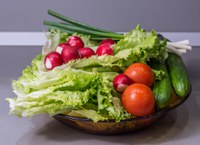Prairie Fare: Smile and Say ‘Leafy Greens’
(Click an image below to view a high-resolution image that can be downloaded)
By Julie Garden-Robinson, Food and Nutrition Specialist
NDSU Extension
“They ate all of it!” I exclaimed.
“You thought they were cute,” my husband commented.
“Not anymore,” I replied.
By this time, I was stomping across the field, looking for the invader. I saw some fuzzy ears poking up above the slightly tall grass.
The furry varmint was about the size of a young kangaroo. He loped across the former prairie as though he owned the place. Prairies were the homeland of bountiful jackrabbits.
My family and I oversee several 4- by 4-foot-square gardens at our church. The rabbit and his kin had eaten all the lettuce. The green beans were reduced to skinny stalks without leaves.
This was not Peter Cottontail’s work. “Jack the Rabbit” and his buddies are large hares in the Leporidae family. Maybe Harold the Hungry Hare would be a better name, or perhaps, Harriet.
We had created a perfect in-ground salad bar. It was a bountiful bunny buffet.
“I should put up a camera,” my husband noted.
The wildlife, including squirrels, in our backyard have entertained us as we watch on “candid camera.”
Harold the Hungry Hare probably would grin and say “leafy greens” at the camera, I thought to myself.
We have a large newly formed community garden at our church. The hares have taken up a new spot behind the church. We have provided some tasty tidbits.
They avoided eating the tomato and potato plants. Those plants are in the nightshade family, and their leaves are toxic in high doses. They also left the zucchini and other squash plants alone.
I will be happy to leave some zucchini for the rabbits later in the season.
What can you do to deter wildlife and save your food for yourself?
We can’t play Elmer Fudd and Bugs Bunny, not in the city anyway.
You can try chicken wire fences and items that deter wildlife with noise, movement or light. Some people use a homemade cayenne pepper and vegetable oil mixture as a nontoxic deterrent for rabbits and other animals.
I would like the rabbits to eat the weeds. We have an abundance of purslane and lamb’s quarters. Those are edible for us, too. The thistles would not be comfortable to chew on, but they probably are fiber-rich, too.
Lettuce and other leafy greens provide vitamin C, which helps our immune system stay strong and helps us maintain the health of our skin, blood vessels and bones. Leafy greens are available in a variety of colors and flavors at your grocery store, farmers market or in your backyard garden.
Challenge yourself to try a variety of leafy greens. Try some looseleaf, butterhead or romaine. You can find red and green varieties of lettuce. If you want a little natural “kick” in your salad, add some peppery arugula.
Beet greens, swiss chard and kale are nutrition all-stars that add variety and nutrition to your salad. Try growing some microgreens, which are immature greens. You can grow them inside all year.
Many of us shortchange ourselves on the amount of vegetables we should consume daily, which averages about 3 cups per day for most adults.
Color can be a cue to nutrition. Aim for a menu with the range of the colors of the rainbow. In general, vegetables with a dark green, orange or gold hue are more likely to be high in vitamin A.
In general, people do not eat enough food from the dark green and orange subgroups of vegetables.
Here's a calorie control tip for salads. Instead of drowning your salad in dressing, put your dressing in a small bowl. Dip the tines of your fork in the dressing before taking a bite.
Think like Harold, Peter and others in the rabbit family: Eat more leafy greens and other veggies.
Have you tried making salad in a jar? You can use a Mason jar (the type used in canning) or another large glass jar with a cover. Your layered salad is rich in fiber, vitamins and minerals. Here's an example of how to layer a salad in a jar.
Create-your-own Salad in a Jar
- Add 2 tablespoons of your favorite salad dressing to the bottom of the jar (or bring in a separate container to add later).
- Add a layer of "hard" vegetables, such as carrots, cucumbers, broccoli and radishes. These vegetables protect the layers from getting soggy.
- Add cooked beans or brown rice next.
- Add protein such as canned tuna, hard-cooked eggs, leftover roasted chicken or other protein.
- If desired, add soft vegetables or fruits such as avocado slices, tomato chunks or diced strawberries.
- Add nuts or seeds, such as almonds, walnuts or sunflower seeds.
- Add salad greens, especially dark green ones (romaine, etc.)
- Top the jar with the lid and store in the refrigerator. When you carry it to work, try an insulated lunch bag to keep it cool.
- You can shake your salad to mix and eat out of the jar or put it on a plate.
- Use within four days for best quality.
(Julie Garden-Robinson, Ph.D., R.D., L.R.D., is a North Dakota State University Extension food and nutrition specialist and professor in the Department of Health, Nutrition and Exercise Sciences. Follow her on Twitter @jgardenrobinson)
NDSU Agriculture Communication - July 1, 2021
Source: Julie Garden-Robinson, 701-231-7187, julie.garden-robinson@ndsu.edu
Editor: Ellen Crawford, 701-231-5391, ellen.crawford@ndsu.edu




